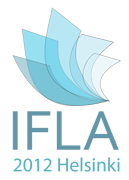Full-day Library Visits: Outside Finland
Friday, August 17, 2012
If you are considering attending one of the Library Visit locations outside of Finland, we recommend making a preliminary booking prior to the Congress via the online registration form. Bookings must be reconfirmed onsite at the Library Visits counter. Delegates must arrange their own transportation and must ensure they arrange all visa and other formalities for travel in advance of the tour. A visa is required for St. Petersburg, Russia.
Tallinn 1, Estonia
Recommended Transportation: Boat and Bus
Nurmennuku Raamatukogu
It is the newest branch library of the 17 branches of Tallinn Central Library. The library, established in 2007, is in Õismäe residential area and is situated in the same building with the leisure centre. As in all the Tallinn branches it has an automated library system and common library card. Internet workstations and Office software are also available as is WIFI connection.
Library of Tallinn University of Technology
A brief stop along with refreshments in the newest library building in Estonia: Library of Tallinn University of Technology.
Jüri Raamatukogu
It is one of the libraries for the general public in Harju County. The public library in Jüri has a long history. In 2006 the library got new premises in the same building together with the local school and sports centre. The library has more than 2000 registered users and a stock of about 40,000 items. The electronic library system is in use, and users have the possibility to use computers, etc.
Tallinn 2, Estonia*
Recommended Transportation: Boat
*Updated!
KUMU Art Museum and its library
For the first time during its nearly 100-year-old history, the Art Museum of Estonia has a building that both meets the museum's requirements and is worthy of Estonian art in its collections. Kumu Art Museum is a multifunctional art museum that includes exhibition halls, an auditorium that offers diverse possibilities and an education centre for children and art lovers of all ages. The museum has an Art-library.
The Museum of Estonian Architecture in the Rotermann Quarter
The Rotermann quarter is uniquely attractive with its old industrial buildings in their new function and modern architecture intertwined. Walk through the historical quarter of Rotermann to get to the Museum of Architecture.
Visit the Museum of Estonian Architecture
St. Petersburg, Russia
Recommended Transportation: Train with one overnight stay
The Imperial Public Library (now the National Library of Russia in St. Petersburg)
The Imperial Public Library (now the National Library of Russia in St. Petersburg) was founded by Catherine the Great on the 27th of May 1725. It became the first publicly accessible library with all functions of a national repository. It holds the most complete collection of books published in the Russian language and on the territory of Russia, 34.5 million items in total. Included in its main treasures are the collection of incunabula and manuscripts, the Rossica Collection (books about Russia published abroad), and Voltaire's Private Library which was purchased by Catherine the Great after the death of the philosopher. The foreign book collection includes more than 6,000 volumes published by the Elsevier family in the 17th century. Among the manuscripts are the first Russian dated book Ostromir Gospel, 1056-1057; the St. Petersburg Codex of the Bible, the earliest Old Testament in Hebrew, 1008-1010, and the largest collection of Greek manuscripts outside Greece.
St. Petersburg State Theatre Library
The St. Petersburg State Theatre Library, one of the oldest libraries in Russia, was founded in accordance with a special decree issued by the Empress Elizabeth in 1756. It was then located in the Alexandrinky Theatre built by architect C. Rossi. In 1889 it moved to a special hall (now ulitsa Zodchego Rossi, 2). By the turn of the 19th and 20th century it became a theatrical archive, collecting the scripts of all the plays performed on the stages of St. Petersburg. Since 1917 the library became more democratic and survived in the difficult post revolutionary years of civil war. At present readers are served in the main reading hall, in the rare books reading hall, through the individual and inter-library loans. The library introduces modern computer and information technologies.
Last update: 13 June 2012

